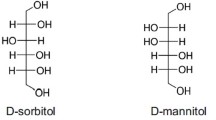Summary
6 patients without evidence for renal, hepatic or pancreatic disease were treated with intravenous infusions of 500 ml hydroxyethyl starch (6%) over a period of 60 min. In the course of the infusion we observed an increase in plasma volume from 2.72±0.101 to 3.36±0.141. After 2h plasma volume decreased to 3.02±0.101 but showed a second peak of 3.23±0.121 after 4h (p<0.01). 24h following infusion an increase in plasma volume of 4,8% was found as compared to preinfusion values. The second increase in plasma volume cannot be explained by the total concentration of hydroxyethyl starch since the latter decreased continuously. The increase in plasma volume was accompanied by a decrease in average molecular weight004Dw and004Dn. It is suggested that serum amylase produces small osmotic active molecules by degradation of hydroxyethyl starch, thus leading to an increase in plasma volume. 12–24h after the infusion of hydroxyethyl starch serum amylase was more than twice as high basal values. This is caused by the formation of a high molecular hydroxyethyl starch-amylase-complex which cannot be eliminated easily. When hydroxyethyl starch is given repeatedly to normovolemic patients, the second increase in plasma volume should be considered as a possible cause for acute hypervolemia. This is especially true for patients with myocardial insufficiency.
Zusammenfassung
6 Patienten ohne Anhalt für eine Nieren-, Leber- oder Pankreaserkrankung erhielten innerhalb von 60 min 500 ml 6% Hydroxyäthylstärke 450/0,7. Während der Infusion stieg das Plasmavolumen von 2,72±0,101 auf 3,36±0,141 an, fiel in der 2. Stunde wieder auf 3,02±0,101 ab und erreichte nach der 4. Stunde einen zweiten Gipfel von 3,23±0,121 (p<0,01). Nach 24h lag das Plasmavolumen noch 4,8% über dem Ausgangswert. Dieser „Volumenzweiteffekt“ ist nicht durch die Hydroxyäthylstärke-Gesamtkonzentration zu erklären, da diese kontinuierlich exponentiell abfiel. Mit dem erneuten Volumenanstieg nach der 4. Stunde ging eine Abnahme des Zahlenmittels004Dn und des Gewichtsmittels004Dw einher. Dies spricht dafür, daß infolge der Fraktionierung durch die Serumamylase vermehrt osmotisch aktive Hydroxyäthylstärke-Moleküle entstehen, die zu einer Zunahme des Plasmavolumens führen. 12–24h nach Infusionsbeginn stieg die Serumamylase auf über das Doppelte ihres Ausgangswertes an. Ursache dieser Hyperamylasämieist die Bildung eines Hydroxyäthylstärke-Amylase-Komplexes, der infolge seiner Größe nur schwer eliminiert wird. Um eine Volumenüberlastung zu vermeiden, muß bei mehrmaliger Infusion von Hydroxyäthylstärke der Volumenzweiteffekt berücksichtigt werden, besonders bei Patienten nit eingeschränkter kardialer Leistungsbreite.
Similar content being viewed by others
Literatur
Bergmann, H., Necek, St.: Klinische Erfahrungen mit der Hydroxyäthylstärke. Zentraleuropäischer Anaesthesie-Kongreß, Bremen, 10.–13. September (1975)
Chaplin, B.H., Mollison, P.L.: Correction for plasma trapped in the red cell column of the hematocrit. Blood7, 1227–1238 (1952)
Chaplin, B.H., Mollison, P.L., Vetter, H.: The body-venous hematocrit ratio: Its constancy over a wide hematocrit range. J. clin. Invest.32, 1309–1316 (1953)
Distler, A., Just, H.J., Philipp, Th.: Studies on the mechanism of Aldosterone-induced hypertension in man. Clin. Sci.45, 743–750 (1973)
Fiegel, P., Höffler, D., Müller, D., Horbach, L.: Die 51 Cr-EDTA-Totalclearance in der klinischen Routine. In: Aktuelle Probleme der Dialyseverfahren und der Niereninsuffizienz. IV. Symposion in Innsbruck vom 25.–27.2. 1971, S. 372–378
Gruber, U.F., Bergentz, S.E.: Autologous and homologous fresh human plasma as a volume expander in hypovolemic subjects. Ann. Surg.165, 41–48 (1967)
Kilian, J., Spilker, D., Borst, R.: Wirkung von 6%iger Hydroxyäthylstärke, 4,5%igem Dextran 60 und 5,5%iger Oxypolygelatine auf Blutvolumen und Kreislauf bei Versuchspersonen. Anaesthesist24, 193–197 (1975)
Köhler, H., Kirch, W., Roloff, B., Weihrauch, T.R., Prellwitz, W., Höffler, D.: Beeinflussung der Serumamylase durch kolloidale Volumenersatzmittel. Verh. Dtsch. Ges. Inn. Med.82, 968–970 (1976)
Köhler, H., Kirch, W., Weihrauch, T.R., Prellwitz, W., Horstmann, H.J.: Macroamylasemia after treatment with hydroxyethyl starch. Europ. J. clin. Invest.7, 205–211 (1977)
Köhler, H., Kirch, W., Klein, H., Distler, A.: Die Volumenwirkung von Hydroxyäthylstärke, Dextran 40 und isozyanatvernetzter Gelatine bei Patienten mit terminaler Nierensuffizienz. In Vorbereitung
Köhler, H., Kirch, W., Vogt, J., Höffler, D.: Pharmakokinetik von Hydroxyäthylstärke bei terminaler Niereninsuffizienz. Verh. Dtsch. Ges. Inn. Med.83, 1976–1978 (1977)
Pitz, H.: Charakterisierung von klinischen Dextranen durch Gelchromatographie. Anaesthesist24, 500–503 (1975)
Richterich, R.: Klinische Chemie. 3. Aufl. Basel: Karger-Verlag 1971
Rick, W., Stegbauer, H.P.: α-Amylase. Messung der reduzierenden Gruppen. In: Methoden der enzymatischen Analyse, H.U. Bergmeyer (Ed.), 3. Aufl., S.918–923. Weinheim: Verlag Chemie 1974
Street, H.V., Close, J.R.: Determination of amylase activity in biological fluids. Clin. Chim. Acta1, 256–268 (1956)
Thompson, W.L., Britton, J.J., Walton, R.P.: Persistence of starch derivatives and dextran when infused after hemorrhage. J. Pharmacol. Exper. Therap.136, 125–132 (1962)
Author information
Authors and Affiliations
Rights and permissions
About this article
Cite this article
Köhler, H., Kirch, W. & Pitz, H. Volumenzweiteffekt nach einmaliger Infusion von Hydroxyäthylstärke. Klin Wochenschr 56, 977–983 (1978). https://doi.org/10.1007/BF01480153
Received:
Accepted:
Issue Date:
DOI: https://doi.org/10.1007/BF01480153




